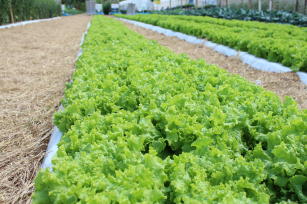Alface BRS Mediterrânea
BRS Mediterrânea Lettuce

Photo: LUDKE, Italo
Due to its origin and domestication, lettuce ( Lactuca sativa) is adapted to regions with mild weather. Cultivating it at higher temperatures combined with the use of unadapted cultivars anticipates blooming, which causes plants to synthesize latex, a substance that gives the leaves bitter taste, decreasing their commercial value and even making trade unfeasible in some cases. In Brazil, lettuce is the main leafy green, and curly green-colored varieties are preferred by consumers. However, the high incidence of soil pathogens has been one of the main problems in the cultivation of this vegetable either in open field or protected cultivation conditions. Such problems can be minimized by sowing the cultivar BRS Mediterrânea, which has tolerance to the main soil pathogens and a good level of tolerance to early blooming. The cultivar BRS Mediterrânea is a curly lettuce with a darker green tone. The plants have vigorous vegetative growth, large size and a thick stem, which allows for easy harvesting and post-harvest handling. It has a short cycle, on average seven days earlier than the most planted curly lettuce cultivar in Brazil, with a production cycle varying according to climate conditions: around 35 days in warmer periods and 45 days in the colder periods. It is recommended for cultivation in all lettuce producing regions of the country, in any production system (open field, protected cultivation, or hydroponics), whose heads reach an average weight between 700 and 800 g within the commonly used spacing. The good levels of tolerance to the fungus Fusarium oxysporum f. sp. lactucae, which causes Fusarium wilt, and to gall nematodes ( Meloidgyne incognita and M. javanica), and of resistance to some Lettuce mosaic virus pathotypes make the cultivar a production alternative in areas with such diseases as it reduces productivity losses. Its tolerance to high temperatures and early blooming caused by heat (that is, even at temperatures that are higher than the optimal temperature range for cultivation, the plant reaches the desirable commercial size at the time of harvest) makes it an alternative farming in warmer areas. The cultivar was developed as part of Embrapa Vegetables' lettuce breeding program, whose main goal is to contribute to the sustainability of the lettuce production chain in Brazil. The cultivar BRS Mediterrânea is registered and protected by the competent bodies of the Ministry of Agriculture and Livestock.
This technological solution was developed by Embrapa in partnership with other institution(s).
Where to find:
AGROCINCO COMERCIO DE PRODUTOS AGROPECUA
RUA CESASIO DE PAULA PENTEADO
CEP:13190000
Cidade: Monte Mor
UF: SP
Telefone: (19)3879-6787
E-mail: LUIS.GALHARDO@AGROCINCO.COM.BR
Product: Cultivar Launch year: 2018
Country: Brazil Region: Central-West, Southeast State: Distrito Federal, Goiás, São Paulo, Espírito Santo, Rio Grande do Sul, Paraná Biome: Cerrado, Atlantic Rainforest
Responsible Unit: Embrapa Vegetables
